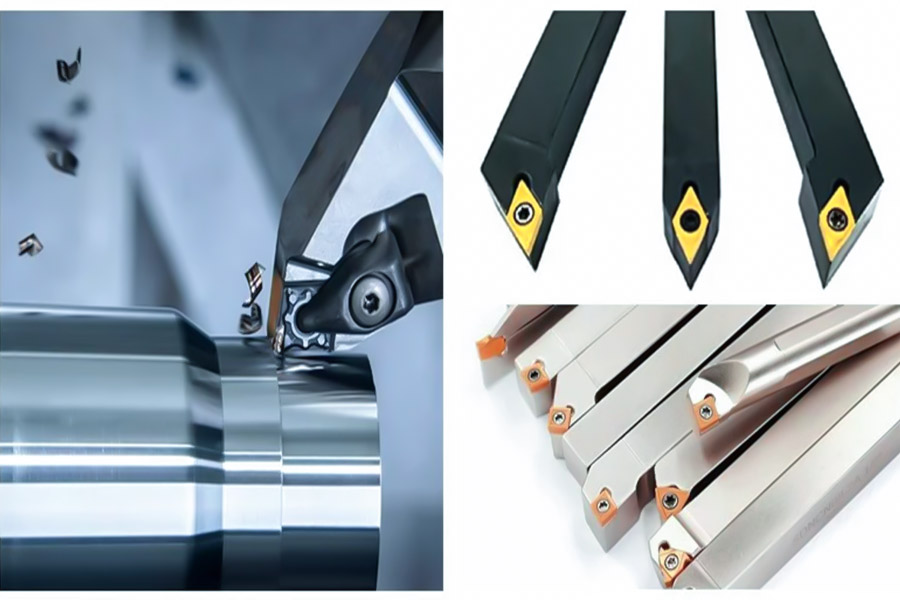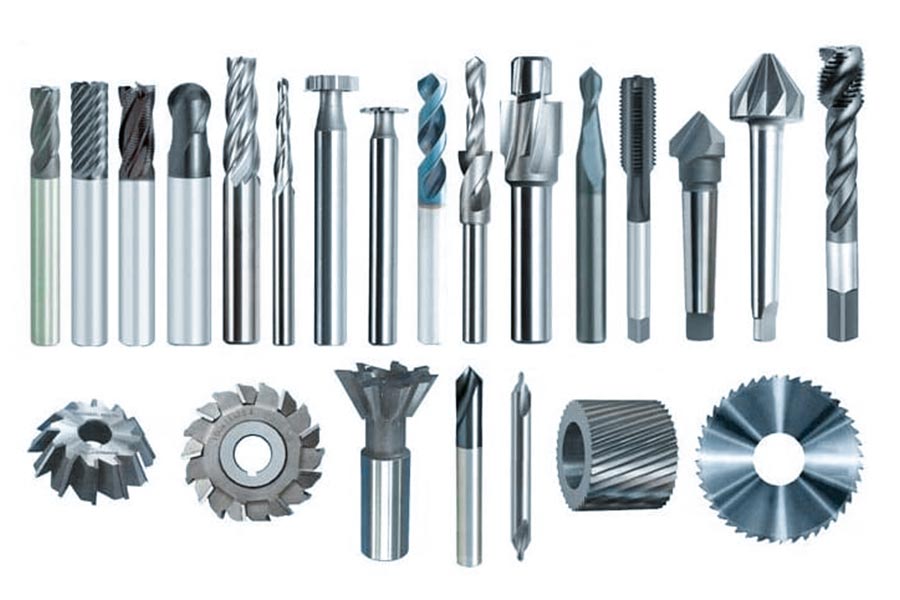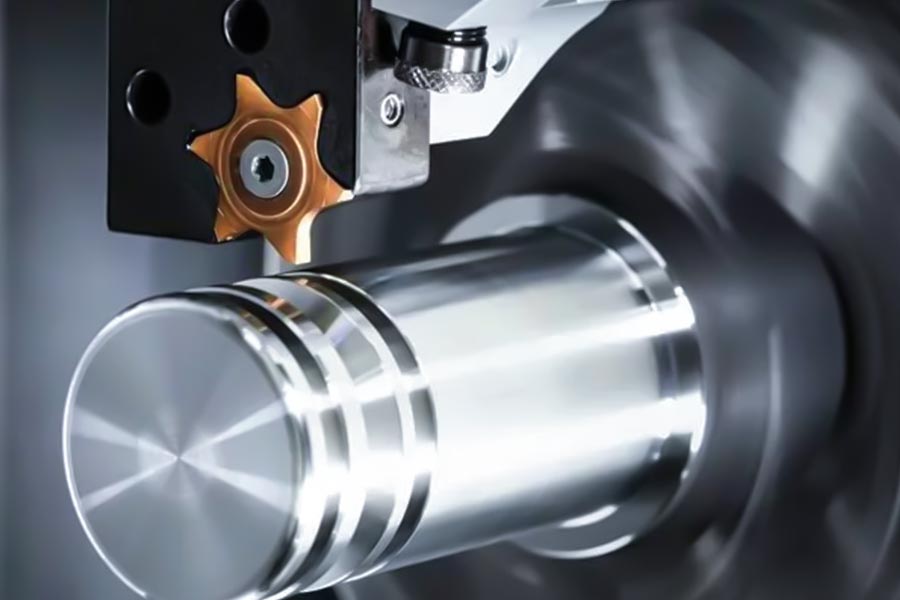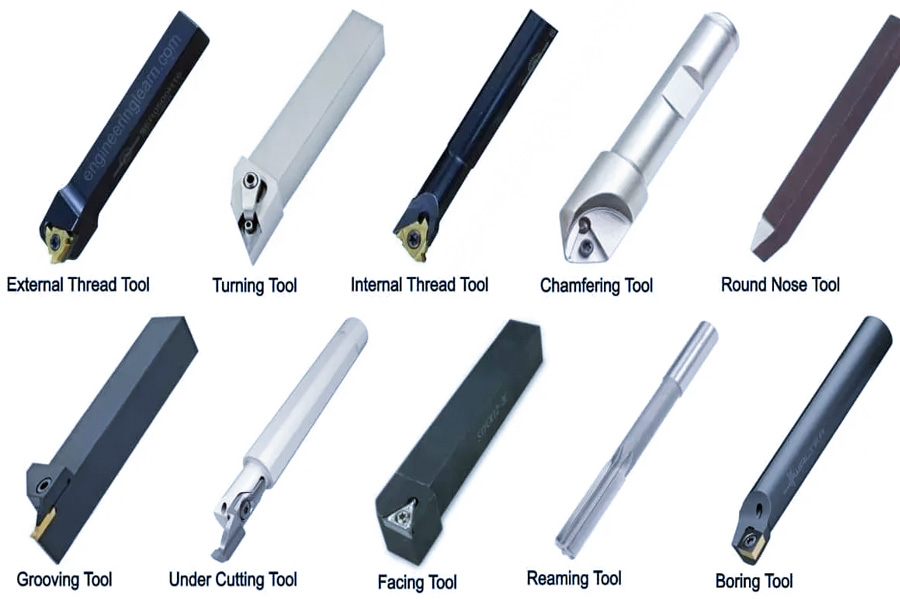On the lathe, the cornerstone ofmetal cutting, the core actuator that gives it the ability to “eat” metal is called a “turning tool”. Behind this seemingly simple generic term is a large and sophisticated family of tools. From the rough and powerful cylindrical machining, to the fine boring of deep cavities, to the precise shaping of threads, each specific turning task corresponds to a special turning tool with a different structure, angle and material.
Whether it is the traditional integral high-speed steel tools, or the modern mainstream carbide indexable inserts, understanding the general name “turning tool” and the rich variety and characteristics behind it is the primary key to mastering turning technology and improving machining efficiency and accuracy. This article will provide you with a systematic analysis of the lathe this “iron tailor” rely on the work of the “teeth” - the world oflathe cutting tools.
What Are the Common Names for Lathe Cutting Tools?
The following is a clear summary of thecommon names of lathe toolsand their core naming system, combined with technical scenarios and practical applications:
1. Commonly used names and technical points of lathe tools
(1) External turning tool (Turning Tool)
Core Function:
Turning external circle, end face, taper and step surface.
According to the main offset angle typology: 90 ° offset tool (good rigidity, turning step axis), 45 ° / 75 ° elbow tool (versatility, taking into account the external circle and end face).
Typical structure:
Cutter body:carbon steelshank (economical) or carbide shank (high vibration resistance).
Modern mainstream: Indexable inserts (e.g. ISO standard CNMG/ DNMG series), supporting quick change of cutting edges.
(2) Cutting off knife (Parting Tool)
Core parameters:
Bit width: 3-6mm (narrow slot design reduces material waste).
Special material: stainless steel / titanium alloy coated blade (e.g. TiAlN plating, high temperature sticking resistance).
Special design:
Reinforcing rib structure: Enhance the rigidity of the cutter body and prevent cutting vibration.
Blade tip chamfering: reduces the risk of chipping and prolongs the life of the blade.
Otherhigh-frequency turning toolnames and technical positioning
| Tool type | Core function | Technical features |
|---|---|---|
| Internal turning tool (boring tool) | Processing deep holes/inner walls | Slender tool bar (overhang ratio ≤4:1), micro blades (such as CCMT) |
| Thread turning tool | Cutting metric/imperial threads | Tool tip angle accurately matches the tooth profile (60°, 55°), high-speed steel/carbide |
| Grooving tool | Turning axial/radial grooves | Double-edged design (left and right feed), chip breaker optimizes chip removal |
| Forming turning tool | One-time turning of complex curved surfaces (spherical/circular) | Customized contour cutting edge, high efficiency but expensive |
The core logic of the naming system
Function-oriented naming:
Directly related to machining objects (e.g. “cylindrical”, “thread”, “cut”) to avoid ambiguity.
Material and structure labeling:
The material of the tool body (carbon steel/carbide) and the type of coating (e.g., TiN/TiAlN) are indicated to clarify the application scenarios.
Parametric marking:
Key dimensions (cutter width, main offset angle) are written in the name to improve the efficiency of selection (example: 6mm cutter).
The naming oflathe tools is a precise combination of "function + structure + parameters", such as "external turning tool (carbide, 75° main deflection angle)" or "4mm stainless steel special cutting tool". Mastering this system can quickly match tools with processing requirements and achieve a win-win situation of efficiency and precision.

Which Tools Create Internal Features?
Below are the core tools used to create internal features on lathes and their key technical parameters, covering key processes such as precision holemaking and internalthread cutting:
Lathe internal surface machining tool system
1. Boring Bar
Core features:
Precision hole reaming, correction of hole eccentricity, turning of internal cylindrical surfaces/tapered surfaces
Minimum hole diameter: up to ø2mm (ultra-fine boring bar + micro inserts)
Technical features:
Vibration damping design:
Carbide/heavy metal shank (density ≥16g/cm³)
Overhang ratio ≤4:1 (example: machining a deep 50mm hole requires a shank diameter ≥12.5mm)
Insert type:
CCMT060204 (80° diamond, tip R0.2mm, finishing)
DCMT11T302 (55° diamond, rough boring impact resistance)
Accuracy Grade:
Bearing hole machining IT7 grade tolerance (±0.015mm)
Surface roughness Ra0.8μm (mirror boring)
2. Internal Thread Tool (Internal Thread Tool)
Core Function:
Cutting metric/imperial internal threads (blind/through holes)
Standard Tooth Angle: 60° (Metric) / 55° (Imperial)
Technical Features:
Reinforced toolholder rigidity:
Internal cooling channel design (coolant directly to the tool tip, chip removal and cooling)
Helical fluted shank (vibration suppression for deep hole threading)
Insert type:
16ER AG60 (full tooth insert, one shot metric thread)
16IR 0.5P (V-shaped chipformer, suppresses stainless steel chip entanglement)
Machining accuracy:
Thread center diameter tolerance 6g/6H grade (GB standard)
Surface roughness: Ra3.2μm (without edge trimming)
Extended tools: complex internal surface processing
| Tool type | Function | Key technology |
|---|---|---|
| Internal hole grooving tool | Turning internal sealing groove/retracting groove | Radial wedge locking mechanism (rigidity increased by 200%) |
| Reverse boring tool | Processing stepped hole/inner end face | Reverse feed design (expanding after inserting the tool head) |
| Internal forming tool | Turning internal spherical surface/special-shaped cavity | Customized blade profile (CAD/CAM pre-simulation required) |
Golden rule of selection
"For small holes, choose thin rods; for deep holes, choose vibration reduction; for threads, choose the tooth angle; for precision, choose the tool tip"
Processing of ø2~5mm micro-holes:
Boring bar material: Tungsten steel monolithic (elastic modulus ≥ 650GPa)
Blade: TCMT020204 (0.2mm tool tip R angle)
Processing of stainless steel internal threads:
Blade coating: TiAlN+MoS₂ composite coating (friction coefficient < 0.3)
Cutting speed: VC=60m/min (with emulsion high pressure internal cooling)
Industry pain point solutions
| Problems | Tool solutions | Parameter optimization |
|---|---|---|
| Deep hole vibration marks (L/D>5) | Damping vibration reduction boring bar | Amplitude suppression>90% (>2000Hz) |
| Internal thread tooth breakage | Full tooth profile blade + axial layered cutting | Cutting depth decrease: 0.5P→0.1P (fine finishing) |
| Small hole roughness tolerance | Diamond boring tool + kerosene cooling | Ra can reach 0.1μm (mirror grade) |
The core tools for lathe internal surface processing are boring cutters and internal thread cutters, and their performance depends on the tool bar rigidity design, blade geometry accuracy and cutting dynamics optimization. Mastering "micro-hole boring vibration reduction technology" and "internal thread full profile forming control" can break through 80% of the internal feature processing bottlenecks.

What Tools Handle Thread Cutting?
The following are the core tools and technical specifications forthread cutting on lathes, covering external threads, internal threads and efficient processing solutions:
Thread cutting tool system
1. External Thread Tool
Core functions:
Turning external threads of shaft/tube parts (metric, imperial, trapezoidal threads)
Processing range: M3~M100+ (far beyond the tap limit, M30 and above have significant advantages)
Technical characteristics:
Blade tooth angle accuracy:
60° (metric thread)
55° (imperial Whitworth thread)
30° (trapezoidal thread, such as Tr40×7)
Structure type:
Indexable insert: mainstream solution, insert model example:
16ER AG60 (full tooth insert, one-time forming M20×2.5 thread)
16NR P1.5 (V-shaped chip breaker, special for stainless steel)
Integral carbide tool: micro thread processing (such as below M3)
2. Die Holder
Core functions:
Clamping round dies (Round Die) Processing low-precision standard external threads
Applicable scenarios: maintenance workshop/small batch M6~M24 threads
Technical limitations:
Precision is only 7H/7g level (lower than level 6 for turning)
Cutting force depends on the machine tool slide to push, easy to vibrate
Not applicable: difficult-to-cut materials such as stainless steel/titanium alloy
Extended tools: Efficient thread processing solutions
| Tool type | Function | Technical advantages |
|---|---|---|
| Internal thread cutter | Turning nuts/valve body internal threads | Rigid toolholder + internal coolant design (applicable to deep holes and blind holes) |
| Thread milling cutter | Five-axis turning and milling compound center for processing special-shaped threads | Can process non-standard tooth profiles and large pitch threads |
| Tornado milling head | Efficient batch processing of screws/lead screws | Cutting efficiency increased by 5~8 times (multi-blade synchronous cutting) |
Thread processing tool selection guide
According to material and precision requirements
| Working conditions | Preferred tools | Key parameters |
|---|---|---|
| External thread for finishing steel parts (IT6 grade) | Indexable external thread cutter | Insert: TiCN coated carbide |
| Deep hole internal thread (L/D>3) | Internal thread cutter + vibration damping tool bar | Cutting speed Vc=25m/min |
| Stainless steel micro thread (M2) | Solid carbide thread cutter | Rake angle γ=15° (chip breaking optimization) |
According to production efficiency requirements
Single piece/small batch: external thread cutter + axial layered cutting method (cutting depth decreasing)
Large batch: cyclone milling head + multi-tooth comb cutter (one-pass forming)
Industry pain point solutions
| Problem | Tool solution | Parameter optimization |
|---|---|---|
| Thread vibration | Carbide vibration reduction tool bar | Spindle speed ≤800rpm |
| Stainless steel sticking tool | Internal coolant thread tool + EP lubricating coating | Feed rate = pitch × 0.95 |
| Blind hole thread root cleaning | Full tooth blade with backing groove | Tip R angle ≤0.1P (P=pitch) |
High-precision/difficult-to-process material threads → Indexable thread turning tools (external thread cutters/internal thread cutters) are preferred
Quick processing of low-precision standard parts → Limited use of die holders (only for small-size carbon steel threads)
High-efficiency mass production → Use whirling milling or thread milling technology

How Are Grooving Tools Defined?
Grooving and Cut-off Tools is a collective term for tools designed to turn axial/radial grooves on rotating workpiece surfaces or to cut off workpieces. Their core feature is a significantly wider head width than normalturning tools, which enables material separation and groove shaping by means of a narrow, tough cutting edge.
Technical classification and parameters of grooving tools
1. Straight Grooving Tool
Core function:
Turning rectangular grooves of equal width (sealing grooves, retreat grooves, oil grooves)
Precision cutting (tool width ≤ 3mm)
Key technical parameters:
Groove width range: 0.5~5mm (width of cutter head = groove width)
Edge strengthening:
Double-sided chamfering (anti-chipping)
Optimization of chipbreaking groove (T-type/V-type groove forced chip rolling)
Precision control:
Slot width tolerance ±0.02mm (precision ground insert)
Roughness of groove bottom surface Ra≤1.6μm
2. V-Shaped Grooving Tool
Core function:
Machining decorative grooves (e.g. anti-skid lines, oil lines)
Turning sealing ring V-shaped groove(O-ring pre-compression structure)
Key technical parameters:
Angle standard: 90° (general purpose) / 120° (heavy duty seal) / 60° (precision air seal)
Knife tip structure:
Symmetric double-edged (left and right cutting edges at equal angles)
Tip R angle R0.1~0.3mm (to prevent stress concentration)
Application Scenario:
Hydraulic piston rod decorative groove (90°)
High pressure valve sealing groove (60°)
Extension type: Special slotting tool
| Type | Function | Technical breakthrough |
|---|---|---|
| Radial slotting tool | Radial feed to turn the end face slot | Cutter body rotation mechanism (±90° steering) |
| Inner hole slotting tool | Processing inner wall ring groove | Elastic deformation tool bar (automatic compensation of slot depth) |
| Multi-tooth combination slotting tool | One-time forming of multiple parallel slots | Adjustable blade set (spacing ±0.05mm) |
Four elements of slotting tool design
Cutting width accuracy → directly determines slot width tolerance (±0.02mm requires grinding of the blade)
Tool body rigidity → width-to-depth ratio ≥1:3 (e.g. 5mm slot depth requires tool body thickness ≥15mm)
Chip removal capability → high-pressure internal coolant hole directly punches the tool tip (pressure > 70Bar)
Cutting edge coating → TiAlN (steel) / diamond coating (non-ferrous metals)
Industry pain point solutions
| Problem | Tool solution | Process parameters |
|---|---|---|
| Wide groove vibration (>8mm) | Chip-splitting step blade | Layered cutting: each layer cutting depth ≤2mm |
| Deep groove chip removal blockage | Internal cooling direct injection tool rod + compressed air | Air-liquid mixed cooling (air pressure>0.8MPa) |
| Carbide chipping | Negative rake angle design (γ=-5°) | Cutting speed Vc=80m/min |
Functional grooving (sealing/retracting) → Choose straight groove cutter, pay attention to the blade width accuracy and chip breaking design
Decorative/sealed groove → Use V-groove cutter, lock the angle tolerance and surface finish
Extreme working conditions (deep groove/difficult to process materials) → Rely on radial feed mechanism and high pressure internal cooling system

What Tools Perform Precision Parting?
The following is a detailed technical analysis and application guide forprecision cutting tools, covering the core parameters and selection logic for industrial-grade cut-off solutions:
Precision Cutting Tool System
1. Carbide Cut-off Tool
Core advantages:
High hardness (HRA ≥ 92) and wear resistance, life expectancy for high-speed steel cutting tools 3 ~ 5 times
Applicable materials:stainless steel, alloy steel, titanium alloyand other hard-to-cut materials
Key technical parameters:
Insert thickness: 2-4mm (rigidity increases exponentially with thickness)
2mm: precision micro-diameter bar cutting (ø ≤ 20mm)
4mm: heavy duty cutting (ø>50mm)
Cutting speed (Vc): 30-80 m/min
Mild steel: 60-80 m/min
Titanium alloy: 30-40 m/min (TiAlN coating required)
Edge strengthening technology:
Negative rake angle design (γ = -6°) for improved impact resistance
Micron-level edge passivation (anti-chipping)
2. High Speed Steel Cut-off Tool (HSS Cut-off Tool)
Core Positioning:
Economical solution (1/3 of the cost of carbide).
Suitable for soft materials such as aluminum, mild steel, copper alloys, etc.
Performance limitations:
Poor red hardness (>600℃ softening), limiting speed Vc≤40 m/min.
Insufficient wear resistance, life expectancy is about 20~30% of Cemented Carbide.
Core indicators of precision cutting
| Parameters | Carbide tool | High-speed steel tool |
|---|---|---|
| Surface roughness | Ra≤1.6μm(precision cutting) | Ra≤3.2μm |
| Verticality of cut surface | ≤0.02mm/10mm | ≤0.05mm/10mm |
| Burr height | ≤0.05mm | ≤0.1mm |
Ultra-precision cutting solution
Diamond coated cut-off tool (PCD Cut-off Tool)
Applicable scenarios:
Mirror cutting of non-ferrous metals (aluminum alloy, copper alloy)
Precision cutting of composite materials/graphite electrodes
Performance benchmark:
Surface roughness Ra≤0.4μm
Cutting speed Vc=300-500 m/min (aluminum alloy)
Ceramic cut-off tool (Ceramic Cut-off Tool)
Applicable scenarios:
Dry cutting of hardened steel (HRC55+)
High-speed cutting of high-temperature alloy(Inconel 718)
Technical parameters:
Vc=150-250 m/min
Tip R angle R0.2mm (to suppress chipping)
Key parameters for process optimization
| Problem | Solution | Parameter adjustment |
|---|---|---|
| Cut surface tilt | Tool tip height ±0.01mm calibration | Tool bar overhang ≤1.5 times tool width |
| Chip wrapping | Internal cooling pressure ≥70Bar | Feed rate f ≥0.1mm/rev |
| Tool chipping | Step-by-step layered cutting | Cutting depth per layer ≤2mm |
Precision cutting requires selecting toolsbased on three dimensions: material hardness, surface accuracy, and cost budget. Carbide tools meet 80% of industrial needs, and diamond-coated tools are the first choice for ultra-precision machining.

Summary
The core name of lathe cutting tools is turning tool,but this is only the starting point of cognition. From the strong deflection tool for external cylindrical turning to the precision boring bar for deep hole diameter, from the efficient and flexible indexable insert to the forming tool with customized contour, the "turning tool" is actually a metal processing execution center that integrates functional diversity, structural innovation and material technology. The precision and efficiency revolution in modern manufacturing is derived from the in-depth mastery of the technicalcharacteristics of turning tools. Only by accurately matching the geometric angles, coating characteristics and working conditions of the tool can the lathe, the "metal dancer", carve out millimeter-level industrial art on the rotating stage with chips as the rhythm. Understanding turning tools is to grasp the core strength of turning technology.
📞 Phone: +86 185 6675 9667
📧 Email: info@longshengmfg.com
🌐 Website:https://lsrpf.com/
Disclaimer
The content of this page is for informational purposes only.LS SeriesNo representations or warranties of any kind, express or implied, are made as to the accuracy,completeness or validity of the information. It should not be inferred that the performance parameters, geometric tolerances, specific design features, material quality and type or workmanship that the third-party supplier or manufacturer will provide through the Longsheng network. This is the responsibility of the buyerAsk for a quote for partsto determine the specific requirements for these parts.please Contact us Learn more information.
LS Team
LS is an industry-leading companyFocus on custom manufacturing solutions. With over 20 years of experience serving more than 5,000 customers, we focus on high precisionCNC machining,Sheet metal fabrication,3D printing,Injection molding,metal stamping,and other one-stop manufacturing services.
Our factory is equipped with more than 100 state-of-the-art 5-axis machining centers and is ISO 9001:2015 certified. We provide fast,efficient and high-quality manufacturing solutions to customers in more than 150 countries around the world. Whether it's low-volume production or mass customization,we can meet your needs with the fastest delivery within 24 hours. chooseLS TechnologyIt means choosing efficiency, quality and professionalism.
To learn more, please visit our website:www.lsrpf.com

FAQs
1. What is the standard name of lathe cutting tool?
The common professional name for lathe cutting tools is Turning Tool, which is an executive tool installed on the lathe to turn rotating workpieces, and is subdivided according to its function to include cylindrical turning tools, cut-off tools, threading tools, boring tools, etc., which together undertake the task of metal cutting and forming.
2. How are lathe cutting tools categorized?
Turning tools are mainly categorized according to three dimensions: functionally, they are divided into cylindrical turning tools (for processing shafts), cut-off tools (for splitting materials), thread turning tools (for cutting threads), and boring tools (for internal hole machining); the structure includes welded, integral, and machine-clamped indexable (modern mainstream); and the material covers high-speed steel, cemented carbide (the dominant), ceramic, and super-hard cutting tools (CBN/diamond).
3. What are the most common types of tools used on modern lathes?
In modern manufacturing, indexable machine chucked turning tools are the absolute mainstream, which use standardized carbide inserts (e.g. ISO model CNMG120408) and are mechanically clamped to achieve rapid edge change, with advantages including 50% higher efficiency (no sharpening), stable insert life, 30% lower cost (reuse of toolholder), and are suitable for high-speed cutting of steel, cast iron, high-temperature alloys, and other materials.
4. How to choose turning tools according to machining needs?
Selection should follow the “material-function-precision” triangle rule: first, according to the workpiece material to determine the tool matrix (steel with carbide, hardened steel with ceramic/CBN, non-ferrous metals with diamond); then according to the machining characteristics of the selection of the function type (cylindrical turning tool to turn the contour, threading tool tapping type, grooving tool grooving); and finally, according to the requirements of the optimization of the accuracy of the Finally, the parameters are optimized according to the precision requirements (0.2mm R angle of the tool tip for finishing, high pressure internal cooling to achieve Ra0.8μm mirror surface).







